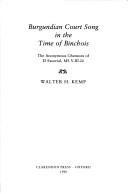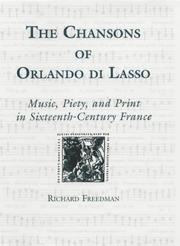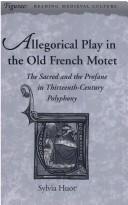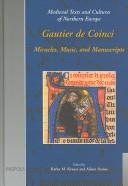| Listing 1 - 10 of 10 |
Sort by
|
Book
ISBN: 9782503515939 2852037378 2503515932 Year: 2004 Publisher: Turnhout, Belgium : Brepols,
Abstract | Keywords | Export | Availability | Bookmark
 Loading...
Loading...Choose an application
- Reference Manager
- EndNote
- RefWorks (Direct export to RefWorks)
Polyphonic chansons. --- Polyphonies françaises --- Polyphonies françaises
Book
Year: 1967 Publisher: [Lieu de publication inconnu]: American institute of musicology,
Abstract | Keywords | Export | Availability | Bookmark
 Loading...
Loading...Choose an application
- Reference Manager
- EndNote
- RefWorks (Direct export to RefWorks)
Chansons françaises --- Polyphonies françaises --- Polyphonies sacrées --- Musique --- Jeux-partis
Book
ISBN: 9782503515328 2503515320 Year: 2004 Publisher: Turnhout, Belgium : Brepols,
Abstract | Keywords | Export | Availability | Bookmark
 Loading...
Loading...Choose an application
- Reference Manager
- EndNote
- RefWorks (Direct export to RefWorks)
Dans l'ombre des plus célèbres compositeurs de la fin du XVe siècle gravitaient nombre de maîtres mineurs. Parmi eux, Jean Fresneau (1468-1505/13) que l'on suppose l'auteur de cinq chansons et d'une messe, est un "chantre" qui exercera ses talents dans deux des plus prestigieuses chapelles de l'époque: la chapelle royale de France et la chapelle ducale de Milan. Fresneau semble être un compositeur assez conservateur, car toutes ses chansons sont à trois voix dans un style généralement qualifié de "chansons bourguignonnes"
Fresneau, Jehan, --- Masses, Unaccompanied --- Polyphonic chansons. --- Polyphonies françaises --- Scores --- Partitions --- Polyphonies françaises --- Messes a cappella --- Scores. --- Fresneau, Jehan, - fl. ca. 1468-1505
Book
ISBN: 9789058678768 Year: 2011 Publisher: Leuven : Universitaire Pers,
Abstract | Keywords | Export | Availability | Bookmark
 Loading...
Loading...Choose an application
- Reference Manager
- EndNote
- RefWorks (Direct export to RefWorks)
Machaut, de, Guillaume --- Composers --- Poets, French --- Poetry, Medieval --- Part songs, French --- Compositeurs --- Poètes français --- Poésie médiévale --- Polyphonies françaises --- Biography --- History and criticism --- Biographies --- Histoire et critique --- Guillaume, --- Poetes francais --- Poesie medievale --- Polyphonies francaises --- Academic collection --- 840 "13" GUILLAUME DE MACHAUT --- Franse literatuur--?"13"--GUILLAUME DE MACHAUT --- Poètes français --- Poésie médiévale --- Polyphonies françaises --- Guillaume de Machaut --- Music --- 500-1400
Book
ISBN: 3775125019 Year: 1995 Volume: 45.
Abstract | Keywords | Export | Availability | Bookmark
 Loading...
Loading...Choose an application
- Reference Manager
- EndNote
- RefWorks (Direct export to RefWorks)
muziekgeschiedenis --- muziektheorie --- Music --- anno 1400-1499 --- Cyprus --- Part songs, Sacred --- Part songs, French --- Church music --- Polyphonies sacrées --- Polyphonies françaises --- Musique d'église --- History and criticism --- Congresses --- Catholic Church --- Congresses. --- Histoire et critique --- Congrès --- Eglise catholique --- Biblioteca nazionale di Torino. --- Chypre --- Church history --- Histoire religieuse --- Polyphonies sacrées --- Polyphonies françaises --- Musique d'église --- Congrès

ISBN: 0198161352 Year: 1990 Publisher: Oxford Clarendon Press
Abstract | Keywords | Export | Availability | Bookmark
 Loading...
Loading...Choose an application
- Reference Manager
- EndNote
- RefWorks (Direct export to RefWorks)
Music --- anno 1400-1499 --- Burgundy --- Polyphonic chansons --- Polyphonies françaises --- Musique --- Analysis, appreciation --- History and criticism --- Analyse et appréciation --- Histoire et critique --- Binchois, Gilles, --- -Polyphonic chansons --- -Chansons, Polyphonic --- Part songs, French --- Art music --- Art music, Western --- Classical music --- Musical compositions --- Musical works --- Serious music --- Western art music --- Western music (Western countries) --- Binchois, Gilles. --- -History and criticism --- de Binche, Gilles --- de Bins, Gilles --- -Part songs, French --- Chansons, Polyphonic --- Polyphonies françaises --- Analyse et appréciation --- Chanson, Polyphonic --- Binche, Egidius de, --- Binche, Gilles de, --- Binchois, --- Binchois, Égide, --- Binchois, G. --- Binchoys, Gilles, --- Egidius de Binche, --- Gilles de Binche, --- Gilles, --- 78.41.2 --- Binchois, Gilles

ISBN: 1580460755 Year: 2000 Volume: 15 Publisher: Rochester (New York) University of Rochester Press
Abstract | Keywords | Export | Availability | Bookmark
 Loading...
Loading...Choose an application
- Reference Manager
- EndNote
- RefWorks (Direct export to RefWorks)
Polyphonic chansons --- Polyphonies françaises --- Lasso, Orlando di, --- -Polyphonic chansons --- -Protestantism --- -Music printing --- Chansons, Polyphonic --- Part songs, French --- Lasso, Orlando di --- -Lasso, Orlando di --- Polyphonies françaises --- Music --- -Music --- Type and type-founding --- Art music --- Art music, Western --- Classical music --- Musical compositions --- Musical works --- Serious music --- Western art music --- Western music (Western countries) --- Religious aspects --- History and criticism --- History --- -History --- -Printing --- Music type --- Music printing --- Protestantism --- Christianity --- Church history --- Protestant churches --- Reformation --- Printing --- Music publishing --- Religious aspects&delete& --- Musique --- Protestantisme --- History and criticism. --- Protestantism. --- Histoire et critique --- Aspect religieux --- Histoire --- Impression --- Part songs --- 16th century --- Texts --- France --- Europe

ISBN: 0804727171 9780804727174 Year: 1997 Volume: *11 Publisher: Stanford, Calif. Stanford University Press
Abstract | Keywords | Export | Availability | Bookmark
 Loading...
Loading...Choose an application
- Reference Manager
- EndNote
- RefWorks (Direct export to RefWorks)
The motet began as a form of sacred vocal music in several parts; a cantus firmus or tenor, drawn from sacred Latin chant, served as a foundation for one or more upper voices. The French motet was a well-established form by the middle of the thirteenth century, as were bilingual motets that combined at least one French and one Latin text among the upper voices. Though some attention is paid to melodic structure and the relationship between text and music, this book focuses on the literary artistry of the texts of French and bilingual motets, notably the special feature of motets that distinguished them from other medieval lyric forms: the phenomenon of polytextuality. The author analyzes both the interaction of the texts within a motet (when there is more than one texted voice) and the relationship between the texted voice(s) and the tenor. Although some French motets employ vernacular refrains as tenors, the vast majority use Latin tenors, thus maintaining an explicit tie to the liturgical origins of the genre. This presence of sacred and profane elements within a single motet presents an interpretive dilemma that the author suggests can be resolved through an allegorical or parodic reading; indeed, she argues that the tension between allegory and parody is an essential feature of the French motet. The book examines the creative juxtaposition of sacred tenors and vernacular lyric motifs, and the resulting interplay of allegorical and parodic meanings, focusing in particular on the female persona as object of desire and as desiring subject, and on the motives of the separation and reunion of lovers. The author's analysis also discusses the links between the French motet and the secular lyric, the allegorization of love poetry in sermons and mystical texts, sacred parody, and the playful use of liturgical and biblical citations in erotic poetry.
Allegorie --- Allegory --- Allégorie --- Music and language --- Music and literature --- Musique et langage --- Musique et littérature --- Muziek en literatuur --- Muziek en taal --- Motet --- Part songs, French --- Part songs, Latin --- Music and literature. --- Music and language. --- Polyphonies françaises --- Polyphonies latines --- History and criticism --- Histoire et critique --- Motets --- Allegory. --- History and criticism. --- Polyphonies françaises --- Musique et littérature --- Allégorie --- Latin part songs --- French part songs --- Part-songs, Old French --- Literature and music --- Literature --- Language and music --- Language and languages --- Choruses --- Part songs --- Part songs, Sacred --- Personification in literature --- Symbolism in literature --- France --- 500-1400 --- Part-songs [French ] --- Part-songs [Latin ] --- Motets - France - 500-1400 - History and criticism --- Part songs, French - 500-1400 - History and criticism --- Part songs, Latin - 500-1400 - History and criticism
Book
ISBN: 9061528437 Year: 1994 Publisher: Leuven Davidsfonds
Abstract | Keywords | Export | Availability | Bookmark
 Loading...
Loading...Choose an application
- Reference Manager
- EndNote
- RefWorks (Direct export to RefWorks)
Music --- muziekgeschiedenis --- meerstemmigheid --- Vlaamse polyfonie --- muzikale vorming --- muziek --- vocale muziek --- polyfonie --- anno 1400-1499 --- anno 1500-1599 --- Flanders --- Flandre --- Musique --- Muziek --- Vlaanderen --- Polyphonic chansons --- Church music --- Polyphonies françaises --- Musique d'église --- History and criticism --- Histoire et critique --- Counterpoint. --- #gsdbM --- 78 <493-17> --- Counterpoint --- -Music --- -Academic collection --- #GGSB: Muziek --- #BIBC:02.43 ALAMIRE --- kunstboek --- overzicht --- musicologie --- Vlaams Gewest [gewest in land België - BE] --- componisten (x) --- Europa [werelddeel] --- iconografisch materiaal --- C3 --- #A9406A --- 521 --- Art music --- Art music, Western --- Classical music --- Musical compositions --- Musical works --- Serious music --- Western art music --- Western music (Western countries) --- Polyphony --- Music theory --- Muziek--Vlaanderen. Vlaams Gewest. Nederlandstalige Gemeenschap in België --- Kunst en cultuur --- Muziekgeschiedenis (Oudheid - Renaissance) --- History and criticism. --- 78 <493-17> Muziek--Vlaanderen. Vlaams Gewest. Nederlandstalige Gemeenschap in België --- Polyphonies françaises --- Musique d'église --- Academic collection --- Burgundy (France) --- Benelux countries --- Vocal music --- 15th century --- Flanders (Belgium) --- 15th-16th centuries --- 78.24 --- Vlaams Gewest [gewest in land België - BE] --- Muziek--Vlaanderen. Vlaams Gewest. Nederlandstalige Gemeenschap in België --- Muziekgeschiedenis --- Polyfonisten --- Lage Landen --- 15e eeuw --- 16e eeuw --- 17e eeuw

ISBN: 9782503520605 250352060X 9782503538990 Year: 2006 Volume: 13 Publisher: Turnhout Brepols
Abstract | Keywords | Export | Availability | Bookmark
 Loading...
Loading...Choose an application
- Reference Manager
- EndNote
- RefWorks (Direct export to RefWorks)
Gautier de Coinci (c. 1177-1236) was a Benedictine prior, a poet and composer, and the author of several very popular religious works, including a large collection of Miracles of the Virgin in French, which enjoyed a wide circulation during the Middle Ages. Gautier drew on multiple Latin sources for his work, embellishing and personalizing them as he adapted them to his poetic design. Conceiving of his collection of miracles as a complete work, Gautier carefully organized the tales into two books, framing each with authorial exordia and lyrics praising the Virgin. In addition to its obvious literary interest, the subsequent manuscript tradition offers a remarkable panorama of medieval manuscript production, in particular due to the fascinating combination of text, music and illustration. Bringing together a select group of scholars from multiple disciplines (including art history, musicology, and literary studies), this collection of essays explores complementary aspects of Gautier, his works, and his manuscripts. The volume offers both breadth and depth in its examination of Gautier de Coinci and his Miracles de Nostre Dame. It promises to redefine Gautier studies through its interdisciplinary consideration of the varied facets of his work as it makes available to scholars and students the first interdisciplinary examination of this key figure in medieval vernacular religious culture.
Music --- Gautier de Coinci --- Manuscripts, Medieval --- Manuscripts, French --- Part songs, French --- Manuscrits médiévaux --- Manuscrits français --- Polyphonies françaises --- History --- History and criticism. --- Histoire --- Histoire et critique --- Gautier, --- Mary, --- Manuscripts. --- In literature. --- Songs and music. --- History and criticism --- Manuscripts --- In literature --- 091 GAUTIER DE COINCI --- 091:78 --- Handschriftenkunde. Handschriftencatalogi--GAUTIER DE COINCI --- Handschriften i.v.m. muziek --- 091:78 Handschriften i.v.m. muziek --- 091 GAUTIER DE COINCI Handschriftenkunde. Handschriftencatalogi--GAUTIER DE COINCI --- Manuscrits médiévaux --- Manuscrits français --- Polyphonies françaises --- French part songs --- Part-songs, Old French --- French manuscripts --- ʻAdhrāʼ --- Arogyamata --- Ārōkkiyamāta --- Birhen ng mga Dukha --- Blessed Lady --- Blessed Mother --- Blessed Virgin Mary, --- Hagnē Theotokos --- Madonna, The --- Mama Mary --- Mare de Déu --- Maria, --- Mariam Astuatsatsin --- Marie, --- Marie Théotokos --- Marii︠a︡, --- Maryam, --- Maryja, --- Meryem Ana --- Miryam, --- Mother of God --- Muíre, --- Nossa Senhora --- Our Lady --- Our Lady of Good Health --- Our Lady of Sorrows --- Our Lady of the Blessed Sacrament --- Qiddīsah Maryam --- Theotokos --- Vierge Marie, --- Virgen María --- Virgin Mary, --- Virgin of the Poor --- Ynang Maria --- مريم --- مريم العذراء --- 성모마리아 --- Our Lady of Emmitsburg --- Majka Isusova --- Coinci, Gautier de, --- Coincy, Gautier de, --- Coinsi, Gautier de, --- Gauthier, --- Gautier de Coincy, --- Mary [Blessed Virgin ] --- Songs and music --- Manuscripts [Medieval ] --- France --- Manuscripts [French ] --- To 1500 --- Part songs --- 500-1400 --- Manuscripts, Medieval - France --- Manuscripts, French - History - To 1500 --- Part songs, French - 500-1400 - History and criticism --- Gautier, - de Coinci, - 1177?-1236 --- Gautier, - de Coinci, - 1177?-1236 - Manuscripts --- Gautier, - de Coinci, - 1177?-1236. - Miracles Nostre Dame --- Mary, - Blessed Virgin, Saint - In literature --- Mary, - Blessed Virgin, Saint - Songs and music --- Mariam Astuatsatsin, --- Meryem Ana, --- Virgen María, --- Ynang Maria, --- Gautier de Coincy (117.-1236) --- Musique --- Ménestrels --- Critique et interprétation --- Moyen âge --- 13e siècle --- Vie intellectuelle --- Mary, - Blessed Virgin, Saint
| Listing 1 - 10 of 10 |
Sort by
|

 Search
Search Feedback
Feedback About
About Help
Help News
News